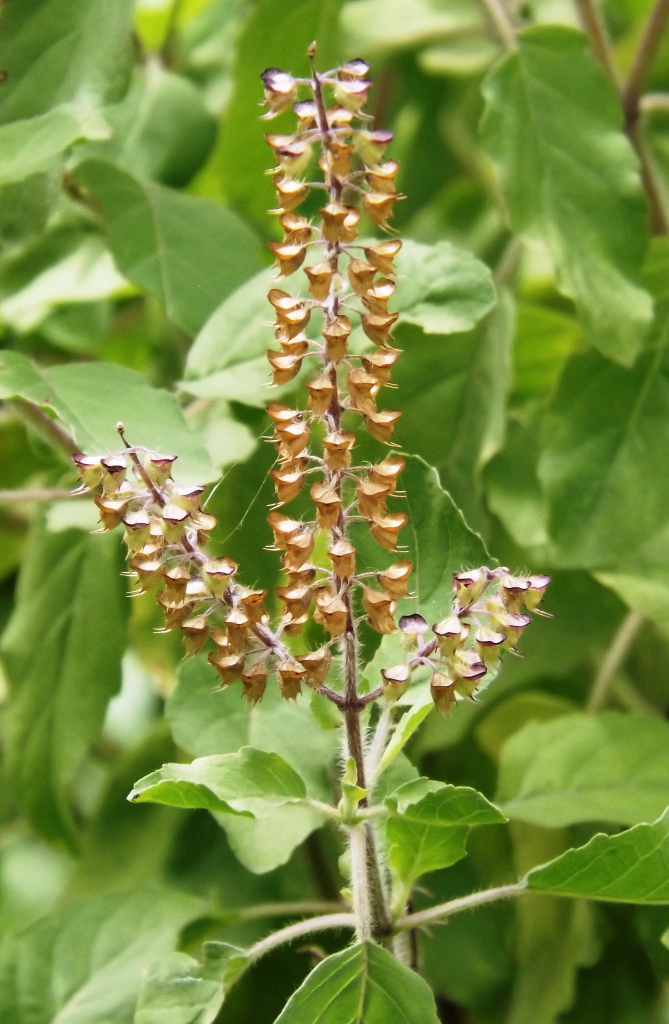How to Care for Tulasī Devī
The author does not pretend to be an expert on this complex subject. However, he has gleaned from one excellent professional source enough information to help the reader cultivate and maintain a beautiful Tulasī plant. This source is a booklet entitled The Art of Caring for Śrīmatī Tulasī Devī, by Īśāna Devī-dāsī. The author recommends it highly, as it contains even more information than is contained in this book, especially in the area of specific pests and diseases that may attack a Tulasī plant. Īśāna Devī-dāsī is not only the caretaker of Tulasī Devī in the New Dvārakā community, but also holds a Ph.D degree in botany from an accredited US university. Persons may obtain her booklet by writing to her at the Los Angeles Temple, ISKCON, 3764 Watseka Ave., Los Angeles, CA 90034 USA or to the Vṛndāvana Trust, Krishna Balaram Mandir, Raman Reti, Vrindavan, Dist. Mathura, India.
The author thanks the anonymous artist of The Tulasī Handbook for the use of some of his/her illustrations to depict this section of the book.
There are two types of Tulasī plants. One, grown in direct sunlight, develops purple leaves and stems, and dark purple to pink flowers-this is called a Kṛṣṇa Tulasī. The other, whose leaves and stems never turn purple and whose flowers are pure white, is called a Rāma Tulasī.
Tulasī’s Latin name is Ocimum sanctum L. Ocimum means she is related to the basil herb, and sanctum means “holy.” Thus she is also known as the “Holy Basil.” There is also a Lakṣmī Tulasī or Tulasa. She is a tree basil and her Latin name is Ocimum gratissmum var. suave (Wild) Hook f. In worship, she is used as a substitute when Tulasī is not available.
Whoever cultivates and cares for a Tulasī plant purifies oneself, gives pleasure to Lord Kṛṣṇa, and obtains Tulasī Devī’s mercy, namely, devotional service to and pure love of Kṛṣṇa.
Starting a Tulasī Plant from Seed

- Either obtain a seed-starter kit from a local nursery, or if you use your own soil, mix of one part potting soil and one part sand. (See soil section below.)
- Place these into peat-moss cups or into flat containers at least two inches deep.
- Remove the four Tulasī seeds from the calyx by shaking them gently or pushing them out with the blunt eye of a needle.
- Place the seeds singly on top of the soil.
- Sprinkle soil finely over them-an amount equal to the diameter of the seed. They should be able to receive light. If planted too deeply, they will not be able to sprout.
- Each seed will germinate into a Tulasī plant, so use only an amount of seeds that you are prepared to care for.
- Do not water the seeds from above as the water could dislodge them.
- Water the containers from below by placing them in a tray of lukewarm water until moist spots manifest on the surface of the soil.
- Let the containers drain completely.
- Place a pane of glass over the containers or place them in a clear plastic bag to increase their humidity.
- Provide them with bright illumination, but not direct sunlight, and keep them in a warm environment.
- Daily remove the moisture that collects on the inside of the pane or bag, and let fresh air circulate about the containers.
- Most Tulasī seeds germinate in three to five days, but some take longer.
- When germination starts, remove the pane or bag. However, keep the seedlings in a humid place, but do not let the planting medium get soggy. (See section on humidity below.)
- For a number of days, as the roots begin developing, the young seedlings will have only two seed leaves.
- If at this stage Tulasī turns purple, she is probably receiving too bright a light. Therefore, the light should be filtered.
- If by chance Tulasī is bent over at the soil line and her stem there is brown and pinched, she has been assailed by a fungus. To overcome this:
- a. Increase the circulation of air.
- b. Reduce the amount of humidity
- c. Sprinkle fine, hot sand onto the soil surface.
- When the Tulasī seedling sends up a shoot with two additional leaves, and then another two, she is ready to be transplanted.
- If the seedling is in a peat-moss container or peat-moss pellet:
- a. When her roots begin to come out of the bottom and the sides of the container, it is time to transplant her.
- b. Transfer the container to a clay pot that is slightly larger and contains the proper amount of potting soil. (See section on soil below.)
- c. Make certain that the new soil line is the same as the line in the container, neither higher nor lower.
- When two Tulasīs are in the same container and you want to transplant each in a separate pot:
- a. First, the seedlings should have at least two or three sets of leaves.
- b. Gently tease apart the container and tease apart the soil mass until the Tulasīs separate.
- c. When two Tulasīs refuse to disentangle, soak them in room-temperature water.
- d. Once the plants are separated, make certain that each has as much soil as possible around the roots. Re-plant at once and water them completely.
- When the Tulasī seedling is in a seed flat:
- a. Scoop out the seedling, taking as much soil around it and below it as possible.
- b. Place her in a small pot and water her completely.
- For several days, keep the seedlings in mild shade. Then gradually increase the light.
- From this point on, the seedling should grow quickly.
- The tip of Tulasī’s stem will grow higher and higher till a flower cluster or mañjarī will begin to manifest.
- Sometimes, before this happens, Tulasī becomes fairly tall. When this happens, and she is still young and her stem not yet woody, she may need to be staked.
- Because wooden dowels rot fast, use bamboo rods or plastic coated steel rods for stakes.
- Place the stake at the edge of the inside of the pot, not near Tulasī’s stem, which may injure her roots.
- Take a piece of clean cloth or kite string and, without interfering with her branches, tie it to her stem. Then tie the other end to the stake. Use as many stakes as required to keep her upright.
- If Tulasī is becoming too top heavy and you wish to terminate her upward growth:
- a. Pinch away the tiny apical growing point on the top of the stem.
- b. This will cause the small buds at the meeting point of each leaf and stem to grow into branches.
- c. When these branches have developed three to four sets of leaves, you can again pinch away the apical growing points. This will cause more side shoots to develop on the branches.
- d. The result? A very compact Tulasī plant.
- Tulasī may never be pruned, to shape her, as is done with ordinary plants, except when doing so will save her life. According to the Padma Purāṇa, it is offensive to cut a living Tulasī branch, and Lord Kṛṣṇa feels this as a pain in His heart.
- Under ideal conditions Tulasī can flower throughout the year. But she develops the greatest amount of flowers during the spring and summer months.
- Tulasī produces clusters of flowers called mañjarīs. The total length of an entire cluster may grow to ten inches.
- Although flowering occurs throughout the year, she generally produces seeds in late spring through summer.
- If you wish to collect Tulasī’s seeds, let the seeds turn brown but cut the mañjarī before the seeds start falling from the calyx. Store these mature mañjarīs with their seeds in a cool, dry, airtight container.
- As a Tulasī plant matures, her new leaves may be smaller, and her stem will become thicker and woody. Most Tulasīs reach an adult height of three to four feet, however some grow to nine feet.
- The duration of most Tulasī plants is about five years.
- After Tulasī leaves her body, her wood can be carved into chanting beads or be employed in fire sacrifices and cremation ceremonies.
For further information about how to properly remove and store Tulasī’s leaves and mañjarīs and use them in worship, see the section on worship.
Keeping Your Tulasī Plant Healthy
Tulasī Devī’s physical health all year round depends on proper light, water, temperature, humidity, soil, nutrients, pot size, and on remaining free from pests and diseases. Here are some of the basics that should be followed.
Notes
1 inch = 2.54 cm













